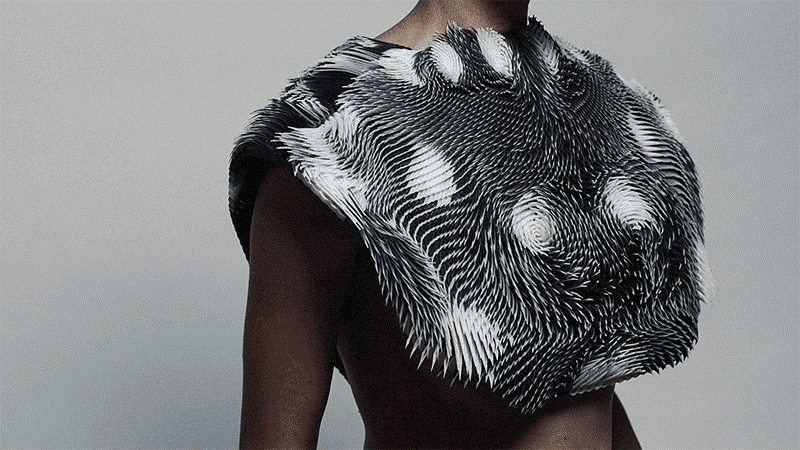The Mind-Bending Works of Behnaz Farahi Give Tech New Life
A USC School of Cinematic Arts student redraws the boundaries between humans and technology.
“Look what I found,” Behnaz Farahi M.Arch ’12 says excitedly, holding up what a Google search later confirms is a seedpod from a magnolia tree. Farahi marvels at the pod’s different textures, the geometrical shapes on its stem, before gingerly setting it down on her desk and vowing to ask her biologist friend about its origins.
In Farahi’s studio space in the USC School of Cinematic Arts building, the seed pod joins a mishmash of wires and electrical detritus that spill from a cupboard, 3-D-printed plastic bits and pieces arrayed behind her computer monitor, and an unadorned dress form sitting next to her rolling chair. This is the milieu of a woman who is unafraid to make worlds collide.
An Annenberg Fellow and Interdisciplinary Media Arts and Practice PhD candidate in the School of Cinematic Arts, Farahi combines architecture, robotics, fashion, art and mechanical and electrical engineering to create responsive environments that seemingly take on a life of their own.

Take, for instance, “Caress of the Gaze.” This wearable cape responds with lifelike behavior as it subtly ripples and shape-shifts depending on a viewer’s line of sight. Or “Aurora,” a kinetic ceiling installation that changes and reacts to the human movement beneath it. Underlying the mind-bending nature of Farahi’s oeuvre is inquisitiveness and a humanization of technology.
Farahi recently sat down with writer Lisa Butterworth to talk about what propels her work and the beauty she finds when art, tech and interactive worlds collide.
What sparked your interest in interactive design?
I started doing my master’s in architecture at USC; I realized that I’m actually interested in something other than conventional architecture. I don’t want to just make buildings and columns and ceilings. For me it was, How can I explore something more? So I got very interested in the idea of interactive architecture and how you can think about architecture as something that can show almost a primitive sort of intelligence—it’s not solid and rigid but it can actually reconfigure based on human presence.
I sense an inherent femininity in a lot of your projects. Am I projecting, or is that something you’re actually instilling in them?
Maybe unintentionally there is something [feminine] from me that comes to the work, but that was never deliberate. In a lot of my work I look at nature. Sometimes it’s reptile skin or fish scales, sometimes it’s different sorts of coral reefs, and I study how they form, how they show behaviors, how they’re all able to respond. There is this plant [called mimosa pudica] and if you touch it, the leaves curl up and close. It’s amazing. I am very interested to explore the sort of intelligence in these systems and try to imitate the intelligence in built form as well.
You seem to have this insatiable curiosity. Has that always been the case?
[Laughs] That’s true, yeah it has. As a kid I made these toys…. If someone came to my room there would be some crazy maze and something might just drop on their head. I made two-person games. Most of the stuff I made was physical, very analog. I had that passion for making stuff. It was playful. I also had an extreme fascination with drawing and painting. My father is an academic and my mother is a school manager; we were a cultural family, so I was exposed to a lot of ideas. Like I was reading Nietzsche with my father at the age of 11. When I think about it, I’m like, What did I understand, really? And what was my father thinking? [Laughs]
Your work seems to have a very optimistic take on how technology can affect us. Where does that optimism come from and where do you see it going?
If you look at the history of cinema, how technology’s been depicted in different movies such as 2001: A Space Odyssey and Star Wars, or even Her to some extent, you see the dark side of technology—that it can go wrong and take over and act against the human. I actually think this shows that although we’re all fascinated by the use of technology, we’re also very, very afraid of it. But the more you ground your work in science, the less you find this kind of prejudice. I agree that I’m quite optimistic about the use of technology, but not in a naive way. Everything starts with “what if” questions, from speculation to design. What if you actually can control things with the power of your mind? This becomes a design challenge for me and I take it from there. So, although there is this skepticism toward technology and people think, Oh, this is the source of alienation, at the end of the day it is up to us to reimagine and devise inventive ways to use these technologies.
